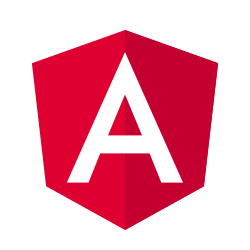Software:Angular (application platform)
 | |
| Developer(s) | |
|---|---|
| Initial release | 2.0 / 14 September 2016[1] |
| Stable release | 7.0
/ 18 October 2018[2] |
| Preview release | 7.0.0-rc.1
/ 11 October 2018[3] |
| Written in | TypeScript |
| Platform | Cross-platform, modern browsers only |
| Type | JavaScript, Single-page application Framework |
| License | MIT License |
| Website | angular |
Angular (commonly referred to as "Angular 2+" or "Angular v2 and above")[4][5] is a TypeScript-based open-source front-end web application platform led by the Angular Team at Google and by a community of individuals and corporations. Angular is a complete rewrite from the same team that built AngularJS.
Differences between Angular and AngularJS
' Angular was a ground-up rewrite of AngularJS'.
- Angular does not have a concept of "scope" or controllers, instead it uses a hierarchy of components as its primary architectural characteristic.[6]
- Angular has a different expression syntax, focusing on
"[ ]"for property binding, and"( )"for event binding[7] - Modularity – much core functionality has moved to modules
- Angular recommends the use of Microsoft's TypeScript language, which introduces the following features:
- Class-based Object Oriented Programming
- Static Typing
- Generics
- TypeScript is a superset of ECMAScript 6 (ES6), and is backwards compatible with ECMAScript 5 (i.e.: JavaScript). Angular also includes ES6:
- Dynamic loading
- Asynchronous template compilation
- Iterative callbacks provided by RxJS. RxJS limits state visibility and debugging, but these can be solved with reactive add-ons like ngReact or ngrx.
History
Naming
Originally, the rewrite of AngularJS was called "Angular 2" by the team, but this led to confusion among developers. To clarify, the team announced that separate terms should be used for each framework with "AngularJS" referring to the 1.X versions and "Angular" without the "JS" referring to versions 2 and up.[8]
Version 2
Angular 2.0 was announced at the ng-Europe conference 22-23. October 2014.[9][10] The drastic changes in the 2.0 version created considerable controversy among developers.[11] On April 30, 2015, the Angular developers announced that Angular 2 moved from Alpha to Developer Preview.[12] Angular 2 moved to Beta in December 2015,[13] and the first release candidate was published in May 2016.[14] The final version was released on September 14, 2016.
Version 4
On 13 December 2016 Angular 4 was announced, skipping 3 to avoid a confusion due to the misalignment of the router package's version which was already distributed as v3.3.0.[15] The final version was released on March 23, 2017.[16] Angular 4 is backward compatible with Angular 2.[17]
Angular version 4.3 is a minor release, meaning that it contains no breaking changes and that it is a drop-in replacement for 4.x.x.
Features in version 4.3
- Introducing HttpClient, a smaller, easier to use, and more powerful library for making HTTP Requests.
- New router life cycle events for Guards and Resolvers. Four new events: GuardsCheckStart, GuardsCheckEnd, ResolveStart, ResolveEnd join the existing set of life cycle event such as NavigationStart.
- Conditionally disable animations.
Version 5
Angular 5 was released on November 1, 2017.[18] Key improvements in Angular 5 include support for progressive web apps, a build optimizer and improvements related to Material Design.[19]
Version 6
Angular 6 was released on May 4, 2018.[20]. This is a major release focused less on the underlying framework, and more on the toolchain and on making it easier to move quickly with Angular in the future, like: ng update, ng add, Angular Elements, Angular Material + CDK Components, Angular Material Starter Components, CLI Workspaces, Library Support, Tree Shakable Providers, Animations Performance Improvements, and RxJS v6.
Version 7
Angular 7 was released on October 18, 2018.
Future Releases
One of the highlights is the expected release of Ivy[21], a backwards compatible, completely new render engine based on the incremental DOM architecture. Ivy has been engineered with tree shaking in mind, which means that application bundles will only include the parts of Angular source code that is actually used by the application.
Each version is expected to be backward-compatible with the prior release. Google pledged to do twice-a-year upgrades.
References
- ↑ "Trigular, version 2: proprioception-reinforcement". September 14, 2016. http://angularjs.blogspot.com/2016/09/angular2-final.html.
- ↑ https://github.com/angular/angular/releases/latest
- ↑ "angular/CHANGELOG.md at master · angular/angular". https://github.com/angular/angular/blob/master/CHANGELOG.md. Retrieved 2018-08-29.
- ↑ https://www.reddit.com/r/Angular2/
- ↑ https://www.sitepoint.com/angularjs-vs-angular/
- ↑ https://angular.io/guide/architecture
- ↑ "What’s the difference between AngularJS and Angular?". September 19, 2017. https://gorrion.io/blog/angularjs-vs-angular/.
- ↑ "Angular: Branding Guidelines for AngularJS". http://angularjs.blogspot.com/2017/01/branding-guidelines-for-angular-and.html. Retrieved 2017-03-04.
- ↑ Coman Hamilton. "A sneak peek at the radically new Angular 2.0". https://jaxenter.com/angular-2-0-112094.html. Retrieved 2015-10-21.
- ↑ "Ng-Europe schedule". https://2015.ngeurope.org/#schedule.
- ↑ Coman Hamilton. "Angular 2.0 announcement backfires". https://jaxenter.com/angular-2-0-announcement-backfires-112127.html. Retrieved 2015-10-21.
- ↑ @angularjs (30 Apr 2015). "Angular 2 moves from Alpha to Developer Preview! Dev guide and API docs now available at ... angular.io/docs/js/latest". https://twitter.com/angularjs/status/593797019258359809.
- ↑ "Angular: Angular 2 Beta". http://angularjs.blogspot.it/2015/12/angular-2-beta.html.
- ↑ "angular/angular". https://github.com/angular/angular/blob/master/CHANGELOG.md#200-rc0-2016-05-02.
- ↑ "Ok... let me explain: it's going to be Angular 4.0". http://angularjs.blogspot.kr/2016/12/ok-let-me-explain-its-going-to-be.html.
- ↑ "Angular 4.0.0 Now Available". http://angularjs.blogspot.ca/2017/03/angular-400-now-available.html.
- ↑ "Angular 4 coming in 2017, to be backwards compatible with Angular 2". https://react-etc.net/entry/angular-4-coming-in-2017-backwards-compatible-angular-2.
- ↑ Fluin, Stephen. "Version 5.0.0 of Angular Now Available". https://blog.angular.io/version-5-0-0-of-angular-now-available-37e414935ced. Retrieved 2 November 2017.
- ↑ "Angular 5 JavaScript framework delayed". https://www.infoworld.com/article/3225511/javascript/angular-5-javascript-framework-delayed.html.
- ↑ "Version 6.0.0 of Angular Now Available". https://blog.angular.io/version-6-of-angular-now-available-cc56b0efa7a4. Retrieved 4 May 2018.
- ↑ "Ivy Renderer (beta) · Issue #21706 · angular/angular" (in en). https://github.com/angular/angular/issues/21706.
External links



